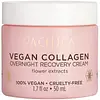What's inside
What's inside
 Key Ingredients
Key Ingredients

 Benefits
Benefits

 Concerns
Concerns

 Ingredients Side-by-side
Ingredients Side-by-side

Water
Skin ConditioningGlycerin
HumectantOleic/Linoleic/Linolenic Polyglycerides
EmollientEthylhexyl Olivate
Skin ConditioningBehenyl Alcohol
EmollientC12-16 Alcohols
EmollientButyrospermum Parkii Butter
Skin ConditioningCaprylic/Capric Triglyceride
MaskingHydrogenated Olive Oil Decyl Esters
Emulsion StabilisingIsostearyl Alcohol
EmollientC13-15 Alkane
SolventButylene Glycol Cocoate
EmulsifyingHydrogenated Lecithin
EmulsifyingPalmitic Acid
EmollientPhospholipids
Skin ConditioningSphingolipids
EmollientCrambe Abyssinica Seed Oil
Skin ConditioningSqualane
EmollientLinoleic Acid
CleansingLinolenic Acid
CleansingMicrocrystalline Cellulose
AbsorbentCitric Acid
BufferingOryza Sativa Bran Extract
Skin ConditioningCaprylyl Glycol
EmollientEthylcellulose
Helianthus Annuus Extract
EmollientSodium Hyaluronate
HumectantTocopherol
AntioxidantCaprylhydroxamic Acid
Xanthan Gum
EmulsifyingPhenoxyethanol
PreservativeSodium Phytate
Potassium Sorbate
PreservativeRosmarinus Officinalis Leaf Extract
AntimicrobialSodium Citrate
BufferingWater, Glycerin, Oleic/Linoleic/Linolenic Polyglycerides, Ethylhexyl Olivate, Behenyl Alcohol, C12-16 Alcohols, Butyrospermum Parkii Butter, Caprylic/Capric Triglyceride, Hydrogenated Olive Oil Decyl Esters, Isostearyl Alcohol, C13-15 Alkane, Butylene Glycol Cocoate, Hydrogenated Lecithin, Palmitic Acid, Phospholipids, Sphingolipids, Crambe Abyssinica Seed Oil, Squalane, Linoleic Acid, Linolenic Acid, Microcrystalline Cellulose, Citric Acid, Oryza Sativa Bran Extract, Caprylyl Glycol, Ethylcellulose, Helianthus Annuus Extract, Sodium Hyaluronate, Tocopherol, Caprylhydroxamic Acid, Xanthan Gum, Phenoxyethanol, Sodium Phytate, Potassium Sorbate, Rosmarinus Officinalis Leaf Extract, Sodium Citrate
Water
Skin ConditioningHelianthus Annuus Seed Oil
EmollientGlycerin
HumectantSr-Hydrozoan Polypeptide-1
HumectantCetyl Esters
EmollientGlyceryl Stearate
EmollientCetyl Alcohol
EmollientStearyl Alcohol
EmollientStearic Acid
CleansingTocopheryl Acetate
AntioxidantDiheptyl Succinate
EmollientCapryloyl Glycerin/Sebacic Acid Copolymer
Skin ConditioningMagnesium Ascorbyl Phosphate
AntioxidantCitrus Aurantium Dulcis Flower Extract
Skin ConditioningJasminum Officinale Extract
MaskingChamomilla Recutita Flower Extract
MaskingArnica Montana Extract
Skin ConditioningAllantoin
Skin ConditioningDipotassium Glycyrrhizate
HumectantXanthan Gum
EmulsifyingPhenoxyethanol
PreservativeEthylhexylglycerin
Skin ConditioningParfum
MaskingWater, Helianthus Annuus Seed Oil, Glycerin, Sr-Hydrozoan Polypeptide-1, Cetyl Esters, Glyceryl Stearate, Cetyl Alcohol, Stearyl Alcohol, Stearic Acid, Tocopheryl Acetate, Diheptyl Succinate, Capryloyl Glycerin/Sebacic Acid Copolymer, Magnesium Ascorbyl Phosphate, Citrus Aurantium Dulcis Flower Extract, Jasminum Officinale Extract, Chamomilla Recutita Flower Extract, Arnica Montana Extract, Allantoin, Dipotassium Glycyrrhizate, Xanthan Gum, Phenoxyethanol, Ethylhexylglycerin, Parfum
 Reviews
Reviews

Ingredients Explained
These ingredients are found in both products.
Ingredients higher up in an ingredient list are typically present in a larger amount.
Glycerin is already naturally found in your skin. It helps moisturize and protect your skin.
A study from 2016 found glycerin to be more effective as a humectant than AHAs and hyaluronic acid.
As a humectant, it helps the skin stay hydrated by pulling moisture to your skin. The low molecular weight of glycerin allows it to pull moisture into the deeper layers of your skin.
Hydrated skin improves your skin barrier; Your skin barrier helps protect against irritants and bacteria.
Glycerin has also been found to have antimicrobial and antiviral properties. Due to these properties, glycerin is often used in wound and burn treatments.
In cosmetics, glycerin is usually derived from plants such as soybean or palm. However, it can also be sourced from animals, such as tallow or animal fat.
This ingredient is organic, colorless, odorless, and non-toxic.
Glycerin is the name for this ingredient in American English. British English uses Glycerol/Glycerine.
Learn more about GlycerinPhenoxyethanol is a preservative that has germicide, antimicrobial, and aromatic properties. Studies show that phenoxyethanol can prevent microbial growth. By itself, it has a scent that is similar to that of a rose.
It's often used in formulations along with Caprylyl Glycol to preserve the shelf life of products.
Water. It's the most common cosmetic ingredient of all. You'll usually see it at the top of ingredient lists, meaning that it makes up the largest part of the product.
So why is it so popular? Water most often acts as a solvent - this means that it helps dissolve other ingredients into the formulation.
You'll also recognize water as that liquid we all need to stay alive. If you see this, drink a glass of water. Stay hydrated!
Learn more about WaterXanthan gum is used as a stabilizer and thickener within cosmetic products. It helps give products a sticky, thick feeling - preventing them from being too runny.
On the technical side of things, xanthan gum is a polysaccharide - a combination consisting of multiple sugar molecules bonded together.
Xanthan gum is a pretty common and great ingredient. It is a natural, non-toxic, non-irritating ingredient that is also commonly used in food products.
Learn more about Xanthan Gum